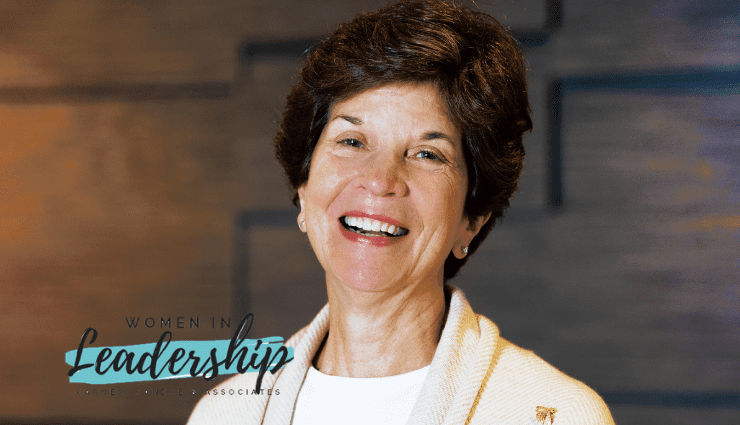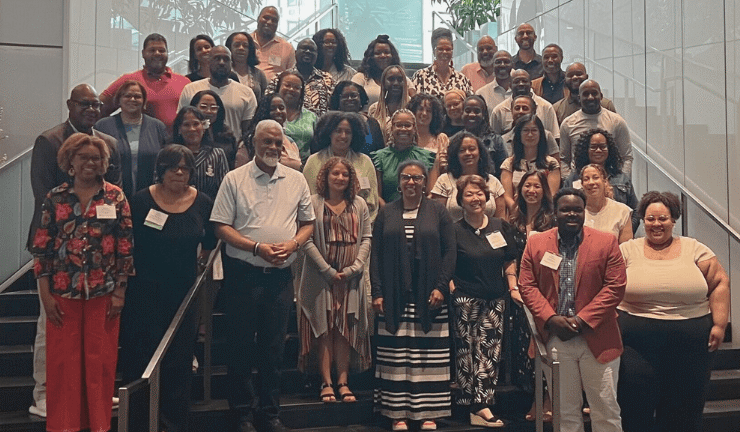Ann Teaff: My Journey to Headship

This spring, CS&A is shining a spotlight on women in leadership. This piece is one of a series of stories about female leaders in independent schools, the importance of mentorship, and their professional journeys. Find the full series here.
CS&A is proud to have hosted the third-annual Women’s Institute on June 14 in Boston, an event designed to support women and their allies in the education community. Our Placement and Search Groups are dedicated to increasing the number of women in leadership roles as part of our commitment to diversity, equity, and inclusion.
One of the advantages of being older is the long view one gains with age. I often marvel at my life because I have had more professional opportunities than I ever dreamed possible.
In addition to the ongoing support and encouragement from my parents, my brothers, and my husband, I credit my mentors with helping me to see possibilities for myself and to have bigger professional dreams than I otherwise might have had.
Three mentors in particular have had an enormous influence on my professional experiences, which run the education gamut from teacher to history department chair to head of the upper school to head of school, and now as a certified coach of school heads and other senior administrators.
After college and graduate school at Vanderbilt University, much to my delight, I secured a position teaching middle school history and English at the University School of Nashville, a large co-educational independent school. I taught middle school for five years and then had the opportunity to move to upper school history. In the high school, it was pure joy to teach many of the same students I had in my middle school classes — each one so bright, eager, challenging, and fun to watch grow and mature. I was about to start my fourth year in the upper school when I suddenly began to think about new opportunities, new challenges.
Enter Mentor #1, John Mason, director of the upper school at University School. One day after school, I stopped in John’s office and told him I was considering leaving University School at the end of the school year. I loved my work, and felt much loved by students, faculty, and staff, yet I was ready for something new and likely in a different part of the country. John told me how much he valued me as a teacher and colleague and wanted me to remain at University School. At the same time, he said, he recognized a change might be good for me. He often said he was sad that I might leave University School and yet he was trying to focus on the best for me. This, I would learn, was the sort of valuable gift a truly caring mentor provides.
John was the first person to tell me about the Klingenstein Fellowship at Columbia University designed to help develop the leadership skills of independent school educators. It was a year-old program and sounded appealing, but not what I was looking for at that time. Five years later, I would indeed receive a Klingenstein Fellowship — thanks to the seed John planted that day — but not yet.
John then talked to me about the NAIS annual conference and the opportunity there to interview for jobs. I only knew of men going to that conference, but with John’s encouragement, I made plans to attend.
John also introduced me to Sandoe & Associates, the teacher placement agency we know today as Carney, Sandoe & Associates. I had never heard of a placement agency that could help teachers secure positions across the country. John helped me with my application for Sandoe & Associates and also helped me begin preparing for job interviews by suggesting questions I might be asked and questions I should ask of the school. Wisely, John cautioned against making a lateral move. “Seek a department chair position,” he said. I never will forget those words, another sign of John’s belief in me and the beginning of my becoming more strategic in thinking about my career as an educator.
That was fall. Five months later, in March of 1980, I went to my first NAIS conference. I had never seen so many blue blazers and tweed jackets in one place as I saw at that conference. Where were the women? At that time, hard as it might be for women today to believe, only around 10% of the attendees at NAIS conferences were women — and that could well be stretching it.
At the conference I discovered there was a newly formed support group for women called Women in Independent Schools. I went to a session where a panel of women was speaking. With the list of the 10 schools from Baltimore to Boston I had interviewed with thus far at the conference, I decided, with trepidation, to walk up to one of the women on the panel when the session ended and ask her for advice about the schools.
The woman I approached, Joyce McCray, became Mentor #2. Joyce, I discovered a bit later, was the head of school at Friends Seminary in New York City and already an iconic woman in independent schools because, among other attributes, she headed a major co-educational school — a rarity at that time for a woman.
Without flinching or wincing with impatience at the thought of sitting down and talking with a young woman she had never seen before, Joyce nodded to the other iconic women on the panel now heading to lunch, telling them she would meet them later. She then sat down and carefully reviewed my list and asked me excellent questions.
One question changed my life: “Why have you crossed through the name of Garrison Forest School? It is a highly regarded day and boarding school for girls.” Joyce went on to explain that there was a wonderful young new head at Garrison Forest by the name of Aggie Underwood who had just moved to Garrison Forest from The Spence School in New York. If nothing else, she said, you should go there to at least meet Aggie. “She could be a valuable woman for you to know.” I will remember those words always.
I did as Joyce suggested — and that’s when Mentor #3, Aggie Underwood, entered my life. I spent 18 wonderful years at Garrison Forest School — first as a history teacher and chair of the department, with one year off, with Aggie’s enthusiastic support, to be a Klingenstein Fellow, then 10 years as head of the upper school.
It is now 38 years later, and I will be forever grateful to Aggie for seeing in me possibilities I did not always see in myself. Aggie is still a great mentor and support as managing associate at Carney Sandoe where I am now a certified executive coach in the executive coaching practice. I value and appreciate her encouragement and support as much today as I did when I was at Garrison Forest. A faithful mentor always.
Now back for a moment to Joyce McCray, Power Woman and Mentor #2. I continued to keep in touch with Joyce, despite being sometimes intimidated by her iconic stature in the independent school world. After she retired from Friends Seminary, Joyce became a search consultant and several years later called me at Garrison Forest — in 1997 to be exact — to talk with me about Harpeth Hall, a girls’ independent school in Nashville where she was the consultant in the search for their next head of school. I had just married — a 47 year old bride! — and was happy at Garrison Forest and not at all thinking about leaving to head a school. In the most loving way possible, however, Joyce and Aggie teamed to encourage me to look at the position, as did my wonderful husband.
I am very glad I listened. I ended up spending 16 incredibly happy years at Harpeth Hall as head of school, loving and appreciating every day, even the really hard ones. While being a head of school is challenging, the opportunities and rewards far exceed the challenges. I began my tenure at Harpeth Hall in 1998, a particularly exciting time in girls’ schools and at Harpeth Hall. We were intent on making certain our teaching and learning focused on ways in which girls learn best, including hands-on and project-based learning across the curriculum. We expanded STEM education experiences for our girls and created a Global Scholars Program. We created a curriculum that focused on the social and emotional health of girls at every grade level, and we created a leadership development curriculum.
We established the Center for STEM Education for Girls to enhance STEM education for our students and girls across the country. We also led the establishment of the Online School for Girls, which expanded the educational opportunities of our students as well as girls across the world. Our Winterim Program, now for almost 50 years a hallmark of the Upper School at Harpeth Hall, expanded to provide increased opportunities for internships, student international exchanges, and educational travel across the country and the world. During my tenure, enrollment at Harpeth Hall increased by 25%, with girls coming from numerous communities across Middle Tennessee.
As head of school, one is charged with thinking strategically about the school of today and the school of the future. It is exciting and exhilarating work and critical to the viability and success of the school.
Although I had limited fundraising experience when I arrived to Harpeth Hall, I quickly learned that my passionate belief in the importance of girls’ schools in today’s world and the key role Harpeth Hall had and continues to play in educating young women would be key to my fundraising success as a head. I am proud to have been a part of two capital and endowment campaigns that raised $87 million for the school, thus significantly increasing the endowment while having the funds to construct five new buildings and extensively renovate all other buildings on the campus. We purchased neighboring properties that enabled the school to build a new Athletic and Wellness Center and increase field space. Some think a head’s job means losing touch with the faculty and students. I am proud that I also visited classes and attended arts and athletics events every week, met one-on-one with faculty and staff almost every year, and knew every girl’s name!
As I look back on the whole of my professional life, I see four messages from my experiences that I view as profoundly important — especially for women who are aspiring leaders in schools:
- We CHOOSE our mentors and role models. The power is in our hands.
- We have to nurture the mentor relationship. It is important for our mentors to know we value them and our relationship with them.
- Listen carefully to the things mentors say. For me, life-changing words were often one simple sentence or question — “Seek a department chair position.” “Have you heard of a Klingenstein Fellowship?” “Why have you crossed through the name Garrison Forest School?” “You are ready to lead a school.”
- Be bold. Reach out — even if it is scary. People want to help. We must let them know that we need and value their help and support.
- Actively work at being one’s best self, at developing the gifts and talents each of us possesses.
- Have faith in the journey of life. Looking back now — with the long view that comes with age — I see how mentors and experiences seemed to almost magically come together, resulting in a life that is more than I ever dreamed. I am deeply grateful.








